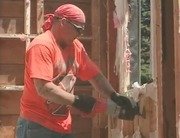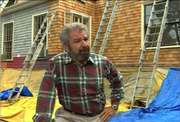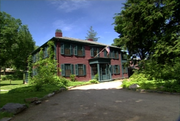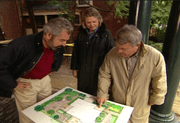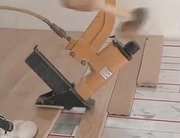Hi I'm Bob Vila.
Welcome home again.
You know today really is kind of the midway point in this project.
We're just about finished with the rough work.
And we're going to be looking at the some of the stuff that gets hidden in the walls before all the plasterboard gets installed.
Also, we'll meet with Rick and Nancy Lamb, our landscape architect here in Cambridge, who are going to help me assess the backyard, figure out what trees to keep and which ones to discard.
Also Rob Riley's on the scene.
He's going to be helping us install a pocket door.
Stick around.
It's good to have ya home again.
Bob Villa's home again.
You know, I'm a firm believer in bringing in the design professionals.
And right now we're going to meet Rick and Nancy Lamb who are landscape architects.
Hi, how are you?
Hi Bob, nice to see you.
Good to see you.
Hi Bob.
And one of the things that we need to talk at this point is what this backyard is gonna do for me.
I mean, it's a sizable backyard, maybe 75 by 30 or 35.
That's pretty close.
And yet we know that we don't wanna create a big grassy area that I have to mow every Saturday morning.
and we know that it's New England climate.
That we have a lot of snow to look at out the windows in the living room, and so forth.
So, you're gonna help me figure out what to do with this backyard.
What are the assets?
We'd like to make it a garden for you, not just a yard.
Yeah, we'll you've inherited some good mature material.
Mm-hmm.
Probably put in a generation ago.
Mm-hmm.
It's also been forgotten probably, for a generation.
Your hemlocks, as you see, will give you wonderful protection.
In corners of the lot we have these hemlocks, right.
And this hemlock, if it were taken away, you would expose a great big five story building.
So, in a good urban garden, that's a nice block.
Yeah.
These hemlocks up here, give you good protection against this house.
But also, or their negative, is that it's they're overgrown and they're, very heavy.
So they need to be, they need to be really thinned out.
And what about things like these rhododendrons?
You know, we've been working here now for several months and they, they in bloom and they're not at all my favorite color.
These are white.
Well, these are white.
Yeah.
And these rhodendrons actually.
You can, you can actually lower and tighten up rhododendrons by removing their new growth and get them a little bit tighter.
This rhododendron here, some of it has died back 'cause of winter.
Right.
This could be cut down.
It happens to not be your color.
It's a hot pink, yeah.
And so, this one probably would be best to either totally and completely remove.
I like that.
And this one -
Here's your best plant.
Your coosa dogwood.
This one here?
Yeah, your -
The coosa dogwood.
I mean the bargains is really just getting to be wonderful with the modulations.
Of course, this rhododendron has to go so that the coosa can thrive.
It's one, your bad color.
Yeah.
It could be fine with the coosa in competition, but you can't really move it because of its proximity to the dogwood -
To the rootball.
Yeah.
- so to really, it really just gets taken out.
Now the coosa as it gets older has this wonderful peeling or exfoliating bark.
Yeah, isn't that beautiful.
And it needs a little bit of pruning.
You've got this one shoot which is not normal to its growth . . .
This one here.
That one.
Yeah.
That goes away.
This, this is really a prize tree.
Unlike the flowering dogwood, which we're used to, this blooms on its leaves rather than before it leaves and it's not susceptible to what's killing the regular flowering dogwood.
Speaking of killing, we had all our red cedar shingles, some of them are treated with fire-retardant, we have them all piled up here and are afraid that all of a sudden the kousa started dropping leaves like mad.
Well, you can see that and one of the reasons it did was here, it's a very aromatic shingle.
Yeah.
And either the vapor from being under the cover, or rain in washing down probably affected it.
Now, having moved it a short time ago, look what's happening, you're getting a whole new regrowth of the leaves that had dropped off before.
Even though
the orientation of the living room is southerly, we're looking kind of directly here.
We
do get views of the neighboring house.
Yes.
One of my concerns is how do we create some privacy without stealing all there
light?
Well, what we want to do is give privacy to their kitchen area.
We'll give them a
filtered view into your garden.
It'll be like giving them the good side of a fence,
because they're material will follow this on and they'll get the fullest part of the
material.
We do want to extend your view down to the spruce and the maples
further on.
So the trick is, since we are in a tight urban situation, is to try to let the eye go far far
away.
The sequence that.
As often as you can.
share and protect.
You want to steal the textures.
Yes.
You want to build new textures from what you seeing a long way.
They'll add
together so the whole pallet is working, whereas in a big country place you're
adjusting it in a whole different manner.
that's why you need the professionals.
Now, the trees here, the hemlock that we're talking about and the ones along the side are real problems and I noticed you brought us an arborist today.
Charlie Cummings is here and is ready, has mounted the tree, and ready to...
Great.
... talk about how to deal with it.
I think I'll climb up there and meet him and interview him and I'll let you guys get back to the drawing board, okay?
Good to see ya.
Great.
Thanks.
Thanks.
Perfect.
Now Charlie, let me interrupt you here for a minute.
Oh hi, Bob.
Hi.
You've got trees here that are probably pretty old, right?
Well you've got four hemlock trees here that are about fifty years old and I really don't think there's been any type of tree-work done in them for that period of time.
No, and we hacked at them a little bit when we were staging up here and rebuilding the roof and stuff, but obviously we haven't done things right.
How do you go about removing some of this growth that's kind of coming right on top of the house.
Well, what I'm doing now is I'm Moving any dead limbs that I find in the tree and I'm pruning them back to a healthy limb.
So you'd be putting a cut, where?
I'm putting a cut right at what we call the collar of the of the limb.
And that way there it ensures that limb is going to heal over properly.
At what you call the collar of the limb?
Mhmm.
Okay.
In that collar you can almost see it and what the tree does is, it will heal over at that point.
And you cut it at a slash?
At an angle, right?
And this particular branch I would cut at an angle because that's where the collar wants to heal.
Okay.
But what about when you have big branches, like you have up there that are eight or ten feet over the roof?
What we're going to do, we're gonna tip back all of these branches to allow more air circulation around the house to eliminate the branches from touching the buildings.
Also -
Lets look at this one, for example.
Show me how, where you would tip something like that.
What we're going to do with this one, and every branch is going to be a little different.
As for what we could take out of the branch.
Because of the fact that what and how many limbs it has growing on it.
OK.
So this particular branch, I can clip back into an area like this.
And you can see that raises right back and gives us fairly good clearance.
OK.
So that the key is kind of gauging how much the big branch is going to lift up.
The key is the... Ronnie, can you take this branch from me?
The key is how healthy the branch is that you are clipping back and how much growth it has on it to do it properly.
And then the key is taking a certain amount of
weight on to see how it's going to bounce back.
Yeah.
And from the homeowner's perspective, though, the key is not to catch a lot of this stuff in the gutters and on your roof.
Absolutely.
And also in the winter, it's great to have all the screening that you get from the tree, the privacy from from the neighboring house and to see the birds and the snow in the bows.
But you don't wanna have these branches rubbing up against you know.
No you don't.
The other thing is we want to thin these lightly to allow more air circulation into the tree.
Yeah.
It allows less wind damage.
We eliminate any hazards such as large broken limbs, so they don't hurt anybody when they fall.
Okay, all right I know your going to have to climb into some of these.
We are going to have to break for messages, don't go away.

